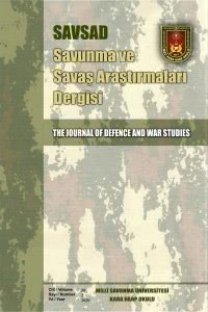INCONEL 718 ALAŞIMININ SERAMİK TAKIMLA TORNADA İŞLENEBİLİRLİĞİNE ETKİ EDEN FAKTÖRLERİN TAGUCHI METHODU İLE ARAŞTIRILMASI
İnconel 718 süper alaşımı sahip olduğu mekanik özellikler nedeniyle yüksek sıcaklıklarda şiddetli mekanik gerilmelere dayanabilen ısıl direnci yüksek, demir-nikel, nikel ya da kobalt esaslı alaşımlardır. Sahip olduğu bu üstün özellikler nedeniyle uçak motorlarında, endüstriyel gaz türbinlerinde, uzay araçlarında, roket motorlarında, nükleer reaktörlerde, denizaltılarda, buhar üretme tesislerinde, petrokimyasal cihazlarda ve diğer ısıya dayanıklı uygulamalarda kullanılmaktadır. İyi yüzey kalitesinin gerekli olduğu bazı durumlarda İnconel 718 malzemesinin talaşlı imalatı zorunlu hâle gelmektedir. Tornalama işlemi talaşlı imalat yöntemlerinin en çok kullanılan yöntemlerden birisidir. Yüzey kalitesi bir malzemenin işlenebilirliğini değerlendirmek açısından önemli bir kriterdir. Tornalamada işlenebilirliği etkileyen en önemli faktörler kesici takım malzemesi, kesme hızı, talaş derinliği ve ilerleme hızı olup İnconel 718 gibi işlenmesi zor olan bir malzeme için araştırılmasında fayda vardır. Tornalamada en uygun işleme koşullarının tespiti için mühendislik istatistiği yöntemleri sıklıkla kullanılmaktadır. Taguchi metodu optimum faktör seviyelerini belirlemek için mühendislik uygulamalarında sıklıkla kullanılmaktadır. Üstün mekanik özelliklerinden dolayı işlenmesi zor olan İnconel 718 alaşımının optimum işleme koşullarının araştırılmasında fayda vardır. Bu çalışmada İnconel 718 alaşımının tornalanmasında işlenebilirliğine etki eden faktörlerin optimum seviyesinin bulunması için Taguchi metodu ile optimizasyon yapılmıştır. Yüzey pürüzlülüğü işlenebilirlik kriteri olarak kabul edilmiştir. İlerleme hızı (0,025, 0,050, 0,075 ve 0,10 mm/dev), talaş derinliği (0,5 ve 1 mm) ve kesme hızı (125 ve 250 m/dak) işlenebilirlik faktörleri olarak seçilmiştir. Deneylerde kesici takım olarak seramik takım kullanılmıştır. Deneyler sonucunda ilerleme hızı % 65 etki yüzdesi ile yüzey pürüzlülüğüne en çok etki eden faktör olmuştur. Faktör etkileşimleri arasında ise ilerleme hızı ile talaş derinliğinin etkileşimi % 10 ile en büyük olmuştur. En düşük yüzey pürüzlülüğü değeri ilerleme hızının 0.025 mm/dev, talaş derinliğinin 1 mm ve kesme hızının 125 m/dak olduğu seviyelerde 0,6356 μm olarak elde edilmiştir.
Anahtar Kelimeler:
İnconel 718, Taguchi, ANOVA, seramik takım, yüzey pürüzlülüğü, işlenebilirlik, tornalama
Investigation of the Factors Affecting the Machinability of Inconel 718 Alloy in Turning by Ceramic Tool with Taguchi Method
Inconel 718 super alloys are iron-nickel, nickel or cobalt based alloys with high thermal resistance, which can withstand severe mechanical stresses at high temperatures due to their mechanical properties. Due to these superior properties, they are used in aircraft engines, industrial gas turbines, space vehicles, rocket engines, nuclear reactors, submarines, steam generating plants, petrochemical devices and other heat-resistant applications. In some cases where good surface quality is required, machining of Inconel 718 material becomes mandatory. Turning is one of the most widely used methods of machining. Surface quality is an important criterion for evaluating the machinability of a material. The most important factors affecting machinability in turning are cutting tool material, cutting speed, depth of cut and feed rate, and it is useful to search for a material that is difficult to machine such as Inconel 718. Engineering statistics methods are frequently used to determine the most suitable machining conditions in turning. The Taguchi method is often used in engineering applications to determine optimum factor levels. Due to its superior mechanical properties, it is useful to investigate the optimum machining conditions of the Inconel 718 alloy, which is difficult to machine. In this study, optimization of the factors affecting the machinability of Inconel 718 alloy in turning with Taguchi method was performed. Surface roughness is accepted as the machinability criterion. Feed rate (0.025, 0.050, 0.075 and 0.10 mm/rev), depth of cut (0.5 and 1 mm) and cutting speed (125 and 250 m/min) were selected as machinability factors. In the experiments, ceramic tool was used as cutting tool. As a result of the experiments, the feed rate was the most effective factor for surface roughness with 65% effect percentage. Among the factor interactions, the interaction of feed rate and depth of cut was the largest with 10%. The lowest surface roughness value was obtained as 0.6356 μm at the feed rate of 0.025 mm/rev, depth of cut of 1 mm and cutting speed of 125 m / min.
Keywords:
Inconel 718, Taguchi, ANOVA, ceramic tool, urface roughness, machinability, turning,
___
- Kitaplar
- Dean, A. ve Voss, D. (1999). Design and analysis of experiments. New York: Springer.
- Hosseini, E., ve Popovich, V. A. (2019). A review of mechanical properties of additively manufactured inconel 718. Additive Manufacturing, 30, 100877. https://doi.org/10.1016/j.addma.2019.100877
- Montgomery, D. C., Runger, G. C. ve Hubele, N. F. (2011). Engineering Statistics (5th ed). Hoboken, NJ: John Wiley.
- Roy, R. K. (2010). A primier on Taguchi method (2nd ed.). Society of Manufacturing Engineers. Şirvancı, M. (1997). Kalite için deney tasarımı “Taguchi yaklaşımı”. Literatür Yayıncılık.
- Makaleler
- Kuram, E., ve Ozcelik, B. (2017). Optimization of machining parameters during micro-milling of ti6al4v titanium alloy and ınconel 718 materials using Taguchi method. Proceedings of the Institution of Mechanical Engineers, Part B: Journal of Engineering Manufacture, 231(2), 228–242. https://doi.org/10.1177/0954405415572662
- Marques, A., Suarez, M. P., Sales, W. F. ve Machado, Á. R. (2019). Turning of ınconel 718 with whisker-reinforced ceramic tools applying vegetable-based cutting fluid mixed with solid lubricants by MQL. Journal of Materials Processing Technology, 266, 530–543. https://doi.org/10.1016/j.jmatprotec.2018.11.032
- Rathod, B. S., Khedkar, N. K. ve Jatti, V. K. S. (2014). Optimization of turning process parameters for surface roughness and MRR based on the Taguchi method during machining of inconel-718. International Journal of Applied Engineering Research, 9(1), 83–92.
- Reddy, T. K., Kosaraju, S. ve Nuka, R. (2019). Experimental study and optimization of turning inconel 718 using coated and uncoated ınserts. Materials Today: Proceedings, 19(2), 512-516. https://doi.org/10.1016/j.matpr.2019.07.645
- Thirumalai, R., Senthilkumaar, J., Selvarani, P. ve Ramesh, S. (2013). Machining characteristics of inconel 718 under several cutting conditions based on Taguchi method. Proceedings of the Institution of Mechanical Engineers, Part C: Journal of Mechanical Engineering Science, 227(9), 1889–1897. https://doi.org/10.1177/0954406212466193 244 Aytaç, Aztekin
- Kongre Bildirileri
- Aztekin, K., Işık, M. S., Aytaç, A., Özdemir, T., Çakır, U. ve Çanakçı, B. (2018, July). Effects of heat treatment conditions and surface roughness on fatigue strength of AISI 4140 steel. International Multidisciplinary
- ISSN: 2718-0301
- Yayın Aralığı: Yılda 2 Sayı
- Başlangıç: 2006
- Yayıncı: MİLLİ SAVUNMA ÜNİVERSİTESİ > KARA HARP OKULU > DEKANLIK
